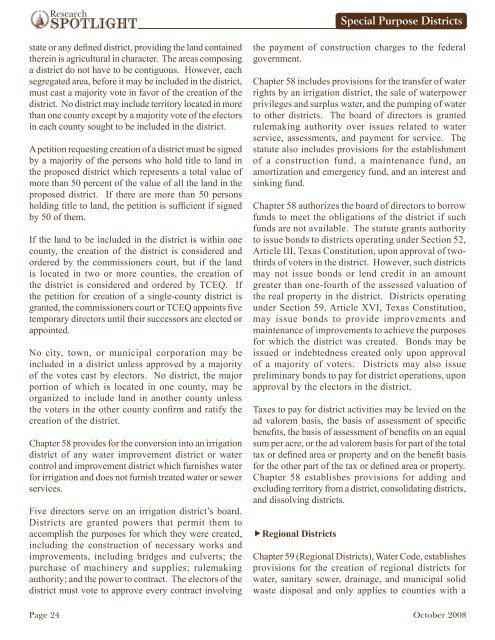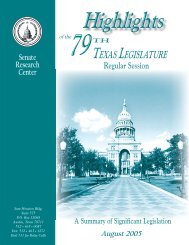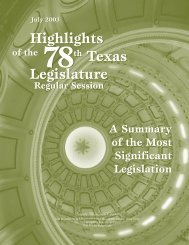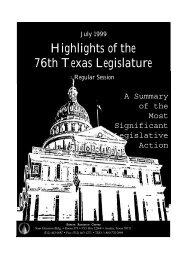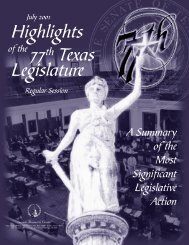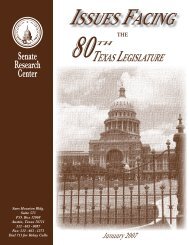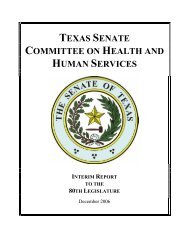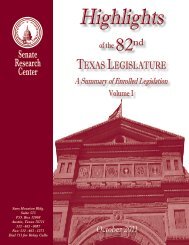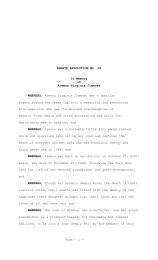Invisible Government: Special Purpose Districts in Texas - Senate
Invisible Government: Special Purpose Districts in Texas - Senate
Invisible Government: Special Purpose Districts in Texas - Senate
Create successful ePaper yourself
Turn your PDF publications into a flip-book with our unique Google optimized e-Paper software.
Research<br />
SPOTLIGHT<br />
state or any def<strong>in</strong>ed district, provid<strong>in</strong>g the land conta<strong>in</strong>ed<br />
there<strong>in</strong> is agricultural <strong>in</strong> character. The areas compos<strong>in</strong>g<br />
a district do not have to be contiguous. However, each<br />
segregated area, before it may be <strong>in</strong>cluded <strong>in</strong> the district,<br />
must cast a majority vote <strong>in</strong> favor of the creation of the<br />
district. No district may <strong>in</strong>clude territory located <strong>in</strong> more<br />
than one county except by a majority vote of the electors<br />
<strong>in</strong> each county sought to be <strong>in</strong>cluded <strong>in</strong> the district.<br />
A petition request<strong>in</strong>g creation of a district must be signed<br />
by a majority of the persons who hold title to land <strong>in</strong><br />
the proposed district which represents a total value of<br />
more than 50 percent of the value of all the land <strong>in</strong> the<br />
proposed district. If there are more than 50 persons<br />
hold<strong>in</strong>g title to land, the petition is sufficient if signed<br />
by 50 of them.<br />
If the land to be <strong>in</strong>cluded <strong>in</strong> the district is with<strong>in</strong> one<br />
county, the creation of the district is considered and<br />
ordered by the commissioners court, but if the land<br />
is located <strong>in</strong> two or more counties, the creation of<br />
the district is considered and ordered by TCEQ. If<br />
the petition for creation of a s<strong>in</strong>gle-county district is<br />
granted, the commissioners court or TCEQ appo<strong>in</strong>ts five<br />
temporary directors until their successors are elected or<br />
appo<strong>in</strong>ted.<br />
No city, town, or municipal corporation may be<br />
<strong>in</strong>cluded <strong>in</strong> a district unless approved by a majority<br />
of the votes cast by electors. No district, the major<br />
portion of which is located <strong>in</strong> one county, may be<br />
organized to <strong>in</strong>clude land <strong>in</strong> another county unless<br />
the voters <strong>in</strong> the other county confirm and ratify the<br />
creation of the district.<br />
Chapter 58 provides for the conversion <strong>in</strong>to an irrigation<br />
district of any water improvement district or water<br />
control and improvement district which furnishes water<br />
for irrigation and does not furnish treated water or sewer<br />
services.<br />
Five directors serve on an irrigation district’s board.<br />
<strong>Districts</strong> are granted powers that permit them to<br />
accomplish the purposes for which they were created,<br />
<strong>in</strong>clud<strong>in</strong>g the construction of necessary works and<br />
improvements, <strong>in</strong>clud<strong>in</strong>g bridges and culverts; the<br />
purchase of mach<strong>in</strong>ery and supplies; rulemak<strong>in</strong>g<br />
authority; and the power to contract. The electors of the<br />
district must vote to approve every contract <strong>in</strong>volv<strong>in</strong>g<br />
<strong>Special</strong> <strong>Purpose</strong> <strong>Districts</strong><br />
the payment of construction charges to the federal<br />
government.<br />
Chapter 58 <strong>in</strong>cludes provisions for the transfer of water<br />
rights by an irrigation district, the sale of waterpower<br />
privileges and surplus water, and the pump<strong>in</strong>g of water<br />
to other districts. The board of directors is granted<br />
rulemak<strong>in</strong>g authority over issues related to water<br />
service, assessments, and payment for service. The<br />
statute also <strong>in</strong>cludes provisions for the establishment<br />
of a construction fund, a ma<strong>in</strong>tenance fund, an<br />
amortization and emergency fund, and an <strong>in</strong>terest and<br />
s<strong>in</strong>k<strong>in</strong>g fund.<br />
Chapter 58 authorizes the board of directors to borrow<br />
funds to meet the obligations of the district if such<br />
funds are not available. The statute grants authority<br />
to issue bonds to districts operat<strong>in</strong>g under Section 52,<br />
Article III, <strong>Texas</strong> Constitution, upon approval of twothirds<br />
of voters <strong>in</strong> the district. However, such districts<br />
may not issue bonds or lend credit <strong>in</strong> an amount<br />
greater than one-fourth of the assessed valuation of<br />
the real property <strong>in</strong> the district. <strong>Districts</strong> operat<strong>in</strong>g<br />
under Section 59, Article XVI, <strong>Texas</strong> Constitution,<br />
may issue bonds to provide improvements and<br />
ma<strong>in</strong>tenance of improvements to achieve the purposes<br />
for which the district was created. Bonds may be<br />
issued or <strong>in</strong>debtedness created only upon approval<br />
of a majority of voters. <strong>Districts</strong> may also issue<br />
prelim<strong>in</strong>ary bonds to pay for district operations, upon<br />
approval by the electors <strong>in</strong> the district.<br />
Taxes to pay for district activities may be levied on the<br />
ad valorem basis, the basis of assessment of specific<br />
benefits, the basis of assessment of benefits on an equal<br />
sum per acre, or the ad valorem basis for part of the total<br />
tax or def<strong>in</strong>ed area or property and on the benefit basis<br />
for the other part of the tax or def<strong>in</strong>ed area or property.<br />
Chapter 58 establishes provisions for add<strong>in</strong>g and<br />
exclud<strong>in</strong>g territory from a district, consolidat<strong>in</strong>g districts,<br />
and dissolv<strong>in</strong>g districts.<br />
ffRegional <strong>Districts</strong><br />
Chapter 59 (Regional <strong>Districts</strong>), Water Code, establishes<br />
provisions for the creation of regional districts for<br />
water, sanitary sewer, dra<strong>in</strong>age, and municipal solid<br />
waste disposal and only applies to counties with a<br />
Page 24 October 2008


